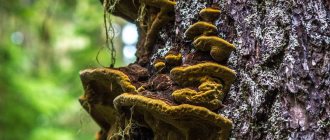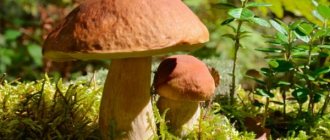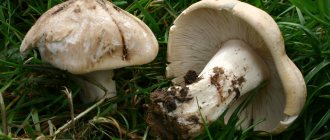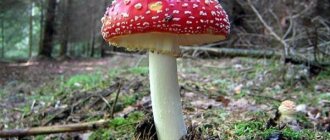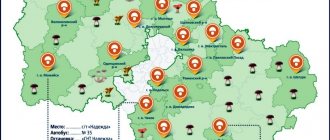Edible mushrooms on a birch tree. Description
Birch tinder fungus, according to various sources, is an edible or inedible mushroom - the opinions of experts on this issue differ significantly.
Its inedibility is supported by its bitter taste, which is less pronounced in young individuals. They are offered to be eaten. The species is considered a prime example of a parasitic organism. The tinder fungus on the birch gradually destroys the tree. The mycelium affects only dry or rotten, i.e. diseased, and therefore weakened specimens, and performs a cleansing function in the forest.
Birch is the only tree on which this species parasitizes.
The birch tinder fungus looks like this:
- the stalk characteristic of cap-legged mushrooms is missing;
- fruiting bodies are annual;
- in young specimens the fruiting body is egg-shaped, in adults it is flat, hoof-shaped, reaching 25 cm in diameter and up to 5 cm in thickness;
- the surface color of the mushroom is white or cream, covered with a film; with age it becomes brown or brown, hard;
- hymenophore – tubular;
- The pulp is white, with a strong characteristic mushroom smell and sour taste.
The species is distributed throughout Russia. Often lives in places with high levels of humidity.
Irina Selyutina (Biologist):
Back in 1967, a book by the Czech scientist V. Ripacek, “Biology of Wood-Destructive Fungi,” was published in Moscow, in which he described the birch polypore species as parasitic, settling on weakened trees. According to currently known data, this species is classified as an active wood destroyer, causing intensively developing yellowish-brown or reddish-brown rot of a destructive type. As a result, the wood very quickly becomes rotten.
The attitude towards the mushroom is ambiguous. Mycologists refer to its inedibility and parasitic nature, and people use its fruiting bodies as a means of traditional medicine. The pulp is not dangerous to humans, but is unsuitable for food due to its irreducible bitterness.
Fast growing boletus
In birch groves, boletus mushrooms or boletus mushrooms grow between the roots of trees. It’s hard to pass by the large caps without noticing them: the fleshy, convex hemispheres have a blunt edge and a light brown color. The bottom of the cap is in the form of a thick sponge, gray-white; brownish spots appear in older mushrooms. The leg is quite long, all covered with dark scales. Mushrooms grow literally by leaps and bounds, and gain 4 cm a day, creating entire glades, although they can live in splendid isolation.
The false boletus has a gray or pink cap on top and bottom.
There are many varieties of boletus, the most common of which are:
- common boletus with a reddish cap and a massive stem, thickening towards the bottom;
- hornbeam with an ashen or gray-brown cap and a thick stem (grows in hornbeam forests).
Edible mushrooms growing on fallen trees. Edible mushrooms growing on trees and stumps
Quite often, wandering through the forests, people come across mushrooms that grow on trees. Most simply pass by and, probably, do the right thing, since among these mushrooms there are few edible ones and even fewer tasty ones. Therefore, in order to collect such forest gifts, you need to be completely confident in their safety. In this article we will try to analyze as fully as possible the topic of edible and inedible mushrooms growing on trees.
Is it possible to eat mushrooms growing on a stump?
More edible mushrooms grow on the ground than on trees and stumps. It is interesting that they are found not only on living plants, but also on dry ones. The most common mushrooms that can be found on a stump or tree are honey mushrooms. They even got their name from the word “stump”. Honey mushrooms can be eaten, they have a very pleasant sweetish taste, and in one trip to the forest you can pick up a whole basket, since they grow in groups.
This type of mushroom is not only edible, but also very useful for humans. One hundred grams of this product contains the daily requirement of zinc and copper.
When collecting honey mushrooms you need to be vigilant. There are a lot of varieties of them and most are harmless, but there are false honey mushrooms, which are very easy to confuse with ordinary ones. These are the ones that are dangerous to human health and even life. In order not to make a mistake, you need to know the main differences between dangerous mushrooms and those that you can or even need to eat.
How to make the right choice
Mushrooms growing on wood:
- flakes;
- liverworts;
- tinder fungi;
- oyster mushrooms
Each of these subspecies is included in the group of poisonous, edible or medicinal mushrooms. We will look at these groups in more detail later in the article.
Edible mushrooms on trees
- Grifola curly. Some mushroom pickers also call it the dancing mushroom. This species is very easy to recognize. It has a fusion between the cap and the stem. Unlike the previous specimen, it has a well-defined taste and pleasant aroma. From June to October, such mushrooms should be looked for at the base of trees such as maples and oaks. Interestingly, one specimen can weigh up to 10 kg.
- Winter honey fungus. Its cap and stem are slightly convex and brown in color. Closer to the center the mushroom darkens. Like griffola, it has tasty and aromatic pulp. Can be found from early autumn until spring. Interestingly, groups of honey mushrooms can be found even under the snow.
- Summer honey fungus. Found in deciduous forests. Summer honey mushrooms can be collected starting in April, and even in November they are still found. The small cap is convex when the mushroom is just growing, and flattens out as it ages. The color of the cap can be yellow or brown.
- Autumn honey fungus. Quite large mushrooms. Their cap reaches a diameter of 17 cm. The scaly legs have a light brown tint. The dense white pulp has a very pleasant taste and aroma. Autumn honey mushrooms grow on trees such as elm, alder, birch, and aspen.
Horn-shaped oyster mushroom. Its light gray hat resembles a horn or funnel. The diameter can reach 12 cm. In the center there is a leg, which is completely strewn with descending plates. Quite elastic and fleshy white flesh. The taste of this mushroom is poorly expressed, the smell is practically absent. You can find oyster mushrooms from May to September on deciduous crops.
At what temperature do mushrooms grow in autumn?
At what temperature do mushrooms grow in autumn?
The main part - the mycelium - is located underground and grows throughout the year in any weather. But intensive growth of fruiting bodies occurs only in autumn. The optimal temperature at which the above-ground part begins to develop is 10-24°C. Some species can be collected at lower temperatures - from 3 to 5°C. However, the lower the temperature, the slower the growth.
Favorable temperature for growth depends on the species. Honey mushrooms are the most cold-resistant mushrooms - they grow best at a temperature of 8-12°C, boletus can be found in the forest at 15-18°C, and saffron milk caps - at 10-12°C. Boletus mushrooms, like saffron milk caps, are best looked for at 10-12°C, and for the formation of oyster mushrooms on tree trunks, the ideal temperature is 10-15°C.
In addition to temperature fluctuations, humidity is important for all species. But with the onset of frost, fruiting slows down or stops altogether.
How long to wait for mushrooms after rain?
Even a good mushroom picker cannot always say exactly how many days after the rain it is better to go to the forest for a new harvest. This is difficult to predict. All mushroom pickers know that after warm light rain or with the advent of fog, when humidity increases, the growth of fruiting bodies accelerates. But you shouldn’t immediately run into the forest.
When to pick mushrooms? For different species it is necessary to wait different times after precipitation. For example, you need to go for honey mushrooms after 2-3 days, saffron milk caps begin to be collected after 4-5 days, but boletus appears the very next day after heavy rain.
Mushrooms growing on an oak tree. Scaly polypore
This is another representative of the group of conditionally edible mushrooms. It is popularly called the hare, pied, or elm. They appear on weak and diseased deciduous trees. A feature of scaly polypores is that they can grow singly, although most often in small groups. These mushrooms grow on walnut trees, oaks, lindens and maples. In addition, it is a fungus that also attacks fruit crops. They prefer a warm climate, which is why they are more common in the southern regions. They grow well both in the forest and in the city. In parks they settle mainly on hazel trees. They bear fruit from late spring to late summer.
Appearance
They have a large fruiting body. The diameter of the cap varies from 15 to 40 cm. In young elms, the cap is shaped like a kidney. Over time it becomes flat. The cap is painted yellow and has scales, as the name suggests. They are colored light brown or brown. Closer to the center the scales are larger and darker. There are also scales on the stem. The lower part of the cap has a tubular structure. The pulp has a pleasant mushroom aroma
Beneficial features
The mushroom is used for medicinal purposes
Medicinal properties allow them to be used in pharmaceuticals. They are part of medications that are used for poisoning with various poisons. They are also included in ointments for nail fungus. In folk medicine, scaly polypores are used to prepare remedies that help fight pathogenic fungi.
Use in cooking
Vyazovik is practically not used in cooking. Dishes should be prepared only from young specimens that have juicy flesh. As it ages, it becomes tough and loses its taste. These mushrooms are soaked before cooking. The duration of heat treatment is 40-50 minutes.
Also edible are boletus mushrooms, which grow near birch groves, and honey mushrooms, growing under aspen trees. Even novice mushroom pickers are familiar with their description. It is impossible to see boletus or honey mushrooms growing on tree bark. They feed from the roots of the host plant.
Recipes for cooking dishes and preparations
Strong mushrooms are good in a variety of dishes - in roasts and sauces, kulebyaki and pies, pickles and marinades. The beneficial properties are perfectly preserved when dried, but only young, tight specimens are suitable for these purposes; old fruiting bodies become watery and dry poorly.
Boletus mushrooms in hot marinade
This delicious, flavorful appetizer is quick to prepare and keeps well.
First of all, prepare the marinade: for 3 liters of water take 600 g of 5% vinegar, 100 g of salt, 120 g of sugar, a little citric acid, spices to taste.
Pre-cleaned mushrooms are boiled in salted water (50 g of salt per 1 liter of water), not forgetting to periodically remove the foam. As soon as the mushrooms have sunk to the bottom, they are ready, they are strained, packaged in jars and boiling marinade is poured on top. The preservation is sterilized for 50 minutes and rolled up.
Boletus mushrooms in tomato sauce
For 3 kg of the finished dish, take 1800 g of peeled and chopped mushrooms, 1 tablespoon of salt, 2 tablespoons of sugar, 1 tablespoon of 9% vinegar, 600 g of tomato paste, 600 g of water, 120 g of odorless vegetable oil, bay leaf, black peppercorns.
The fruiting bodies are cut into pieces, simmered in vegetable oil until softened, and tomato diluted with water is added. The workpiece is heated, salt, sugar, vinegar and spices are added. Mix everything thoroughly, bring to a boil and keep on low heat for 5 minutes. The mass is placed in jars, sterilized for 50 minutes and rolled up.
Boletus mushrooms with vegetables
For this healthy dish, take 1 kg of chopped fruit bodies, zucchini, squash, tomatoes, 300 g of tomato sauce, flour, vegetable oil, and spices.
Young zucchini and squash are cut into pieces, dipped in flour and fried in oil. The mushrooms are lightly blanched and fried. The tomatoes are divided into four parts and simmered until softened. All ingredients are mixed, poured with tomato sauce, salt, pepper and boiled until tender. The food is served hot or cold.
Everyone was successful with boletus mushrooms - beautiful, nutritious, tasty mushrooms, famous for their productivity and long-term fruiting. A knowledgeable mushroom picker will never be left empty-handed and, after a mushroom rain, he will easily find the stout caps under birch, hornbeam or poplar trees, notice the sturdy ones peeking out from under the leaves in swampy lowlands and on the edges of light birch groves, and will definitely fill the basket with these fragrant gifts of nature.
You will learn more about boletus mushrooms (boletus mushrooms) from the video.
Porcini mushrooms on a birch tree. White birch mushroom (Boletus betulicola)
Taxonomy:
- Division: Basidiomycota (Basidiomycetes)
- Subdivision: Agaricomycotina (Agaricomycetes)
- Class: Agaricomycetes (Agaricomycetes)
- Subclass: Agaricomycetidae (Agaricomycetes)
- Order: Boletales
- Family: Boletaceae
- Genus: Boletus (Boletus)
- Species: Boletus betulicola (Birch white mushroom)
The white birch mushroom belongs to the genus Borovik. This mushroom is an independent species or form of porcini mushroom.
In some Russian regions it has acquired the local name kolosovik. This was due to the fact that the first appearance of fruiting bodies coincides with the heading of rye.
The cap of the white birch mushroom reaches a diameter of 5 to 15 cm. When the mushroom is still young, its cap has a cushion shape, and then takes on a flatter appearance. The skin of the cap is smooth, sometimes also slightly wrinkled, but it is shiny and has a whitish-ocher or light yellow color. This mushroom is also found with an almost white cap. The flesh of the porcini mushroom is birch white in color. Its structure is dense, with a pleasant mushroom smell. After cutting, the pulp does not change its color and has no taste. The mushroom stalk varies in height from 5 to 12 cm, and its width reaches from 2 to 4 cm. The shape of the mushroom stalk is barrel-shaped, solid, and whitish-brown in color. The leg of the upper part has a white mesh. The tubular layer of the young white birch mushroom is white, then it becomes light yellow. It looks free or can grow narrowly with a small notch. The tubes themselves have a length of 1 to 2.5 cm, and the pores are round and small. As for the bedspread, there are no remains of it. The spore powder of the mushroom is brown in color, and the spores are smooth and spindle-shaped.
Harvest chanterelles
Chanterelle mushrooms are permanent inhabitants of mixed forests, although they also love coniferous plantings. They grow in large families until the very end of autumn, especially in rainy summers. The diameter of the funnel-shaped cap is small, up to 10 cm, but it is very fleshy, colored in a beautiful yellow color, the edges are wavy and rolled down. The pulp is slightly lighter, dry and elastic, has a sharp taste and smells of dried fruit, and does not turn black when broken. The cap at the bottom smoothly tapers, and its thick plates turn into an elongated stem. It is smooth, the same color as the cap.
The inedible counterparts of chanterelles are more saturated in color: they can be bright orange or reddish. In addition, they do not have a corrugation along the edge of the cap.
Gruzd Black
Black Breast Lactarius Necator is a mushroom from the genus Milky, the Russula family, known under many popular names - Nigella, Gypsy or Chernysh.
Appearance
The cap is up to 20 cm in diameter, flat-shaped, depressed in the center, sometimes widely funnel-shaped with a felt edge turned inward. The skin on the cap is dark olive in color, with barely noticeable concentric zones. The color palette of the cap can vary from dark olive and yellowish-brown to dark brown. The surface of the cap is slimy or sticky in wet weather.
The hymenophore is lamellar, the plates descending along the stalk, thin and frequent, forked-branched. Spore powder is pale cream in color.
The leg is up to 8 cm high and up to 3 cm in diameter, mucous and smooth, sometimes has depressions on the upper surface. The stem, most often, is the same color as the cap, sometimes a little lighter in the upper part; in young fruiting bodies it is solid, but over time, a cavity forms in it.
The pulp is dense and brittle, white in color, turning gray when cut. It produces abundant white milky juice, which has an extremely pungent taste.
Where and when does it grow
This species grows from mid-July to mid-October in mixed forests, in mosses and forest litter, in grass along the sides of forest roads, in light forest clearings. Usually found in large, close groups. Peak fruiting of black milk mushrooms occurs from mid-August to late September.
Culinary use
This mushroom belongs to the category of conditionally edible and is considered edible only after preliminary soaking and boiling. Usually eaten fresh or salted. When salted, it tends to turn purple-burgundy. The mushroom must be soaked to remove the caustic milky juice.
Application
The use of birch tinder fungus in everyday life is widespread. Its medicinal properties formed the basis of traditional medicine recipes.
Cooking
Birch polypores do not have wide culinary uses. But some mushroom pickers suggest eating young spring specimens. There is less bitterness in them, but it only intensifies with heat treatment. The taste of the fruiting bodies is low, so there is no point in cooking it.
Medicine
The medicinal properties of this species were discovered in ancient times. The keratinized skin was removed using whole fruiting bodies and disinfected.
Beneficial substances contained in the pulp help with weight loss:
- weaken appetite;
- have a diuretic effect;
- treat constipation and cleanse the intestines.
A general stimulating effect on the body is also noted. During the cold season, tincture of birch polypore will strengthen the immune system, improve overall mood and emotional background.
Medicinal tinctures and rubs from birch polypore are used for joint diseases and wound treatment. The pulp contains natural anti-inflammatory substances. Fruiting bodies cut into strips are used as a bandage for small open wounds.
In medicine, the following is obtained from the fruiting body:
- Polysaccharides that serve as the basis for experimental drugs in the treatment of oncological problems.
- An extract (or extract) that has an anti-inflammatory effect and works as a pain reliever.
- Chitin and pectin, used to make colon cleansers and dietary supplements.
- Polyporenic acid isolated from fruiting bodies in the laboratory. It is part of medications against ulcers and inflammation of the gastrointestinal tract.
- Some biologically active substances that are beneficial for the functioning of the liver and kidneys help cope with infiltrates.
- Powder made from ground pulp. It is a good antiseptic for wounds and promotes healing.
All preparations and tinctures are obtained only from safe polypores on birch. The false polypore species is not used for medicinal purposes. Specimens collected in environmentally unfavorable places are also not used.
- Author: Maria Sukhorukikh
Rate this article:
- 5
- 4
- 3
- 2
- 1
(0 votes, average: 0 out of 5)
Share with your friends!
Contraindications
Be sure to consult a specialist
Contraindications for external use are the presence of allergies or individual intolerance to the components of mushroom-based preparations. Folk recipes using birch polypore are not recommended for testing on children, the elderly, pregnant women and people with chronic diseases of the skin and joints.
Before using tinctures internally, consultation with a specialist is required.
Growing and care at home
Porcini mushroom can be cultivated in the garden, but to do this you need to organize a symbiosis between the mushroom and the tree. Therefore, the site should be located close to a forest or grove. This mushroom is grown from spores that are located in the cap, from mycelium and pieces of mycelium.
During cultivation, the porcini mushroom needs to be watered partly. Before frost, the area should be insulated by placing straw or leaves on the mushroom growing area. Usually the harvest will please you within a year.
Greenfinch
It is also a row of green , yellow or lemon . Cinderellas are typical autumn mushrooms that bear fruit until the very first light frosts - when other edible mushrooms are no longer available. It happens that greenflies are collected from under the snow.
Mycorrhiza forms with coniferous trees, mainly with pine trees. Prefers to grow on sandy or sandy loam soils. It appears most abundantly in forests from September to November .
Lately there has been talk around the greenfinch about its toxicity. European researchers claim that it can be poisoned, especially if you eat a large amount of mushrooms. In our country, this mushroom has been considered edible for centuries, however, experts strongly recommend consuming greenfinch only after pre-treatment (boiling) and in moderate quantities.
Mr. Summer Resident recommends: tree mushrooms - beneficial properties, use in cooking
The tree mushroom Chaga birch has become famous for its medicinal properties - teas and decoctions from it have a powerful immunostimulating and tonic effect.
Planting mushrooms on a farm has become a profitable business and now we often see tasty and nutritious oyster mushrooms on sale, which are also classified as woody mushrooms. In nature, they come in yellow, greenish and other shades and grow in a large family. Forest species are much more fragrant than their artificially bred relatives. A big plus is that they do not have poisonous counterparts.
Tree ears, as the mushrooms are called because of their resemblance to the shell of an ear, are very popular in oriental dishes. However, they are rarely prepared as an independent dish, since they do not have a special aroma or pronounced taste. Mushrooms are good as a side dish in combination with meat, giving it a subtle smoky flavor. The crispy and dense consistency is pleasant to the taste and nutritious, especially well seasoned.
Undoubtedly, tree mushrooms have taken their rightful place in human nutrition: it is not for nothing that we are increasingly seeing them on supermarket shelves, thereby enriching the diet with healthy and nutritious protein products.
It rained for almost two months, so there were more mushrooms in the forests than ever before, and their diversity was simply off the charts. Mushrooms of coniferous forests are written about in the article Mushrooms of Coniferous Forests, in a report on a trip to the Altai Mountains. The idea to write an article on birch forest mushrooms arose after a trip to Kolki, located 180 km from the city where I live. And this happened literally on the second day after I returned from Altai. My friend, a lover of peaceful hunting, literally pulled me out of the house and forced me to go pick mushrooms; I, of course, didn’t really want to, but the opportunity to collect boletuses, boletuses and boletuses in a new place for me took over.
Similar species
The birch tinder fungus has species similar in biology:
- fox tinder;
- the tinder fungus is real;
- false tinder fungus.
The fox polypore has a smaller size and a reddish color (externally and internally) in comparison with the birch polypore, which in addition is also distinguished by the folded shape of the fruiting body. It is thicker and hoof-shaped. The false polypore has a reddish-brown fruiting body, the flesh inside it is brown. The fruiting bodies of the false polypore species are perennial, they are very firmly attached to the surface of the tree trunk. The real tinder fungus, like the false tinder fungus, has a perennial fruiting body, but unlike it, it is characterized by the presence of a stalk, with which it is attached to the tree. Its flesh resembles a cork.
Birch tinder fungus is often confused with chaga. Chaga is a separate species of the kingdom Mushrooms, a sterile form of the beveled tinder fungus. Its fruiting body looks crumpled in appearance and resembles a black growth. It also parasitizes birch, the nomenclature name is Inonotus oblique or black birch mushroom.

